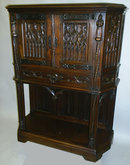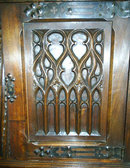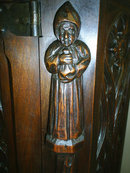Gothic Cabinet (Dressoir)




Unavailable
Description We find dressoirs such as this one to be difficult to resist on the rare occasions that they come on the market in Europe. It embodies one of the earliest innovations of the Middle Ages when a chest was flipped onto a table and a cabinet, for storing valuable textiles and plate, was born. As a piece of useful furniture, it stayed in vogue through the Renaissance but died out in the late 16th century when completely enclosed cabinets, without an open bottom or pot-board, became all the rage in Paris.This dressoir is more diminutive in stature than the typical 19th century reproduction of the Gothic pieces from museums around France. Since the overall shape is hexagonal rather than rectangular, most likely the design was based on a piece from the later Middle Ages, when more sophisticated woodworking techniques allowed craftsmen to attempt designs involving other than right angles. The decorative elements that made these earlier dressoirs so beloved are faithfully executed here. For example, the panels comprising the two doors on the front of the cabinet are true to designs of the past with a series of lancet arches supporting fenestrage or tracery made up of elliptical and tear-drop shapes even more intricate carving. The rhythmic nature of the arches and tracery lends a pleasing effect as it attracts the eye to the intricacy of the design and the central themes of the cabinet.Panels that are narrower and based on pointed arches rather than ogives, make up the four side panels of the cabinet. The larger quatre-foil design of the tracery is remarkable to find in a side panel, leading us to think this may have been a specially commissioned piece since otherwise the side panels would have been a simpler, plis-de-serviette design, as seen at the back of the pot-board.Framing the outer edges of each door is a robed and hooded figure, standing on a pedestal, and whose back is part of the vertical frame of the cabinet. The figures are simply carved, adding yet another reference to this cabinets roots in medieval architecture and the figures of the prophets from cathedrals such as Amiens. Below their feet is a column with the diagonal design of intricate carving, again reminiscent of cathedral design.The top part of the cabinet includes one wide drawer whose decoration is tracery --elliptical shapes which are echoed on the sides as well, to form a united frieze separating the top of the cabinet from the pot-board. Reference Boccador, Jacqueline, Le Mobilier Français du Moyen Age à la Renaissance, Editions dArt Monelle Hayot (Saint-Just-en-Chaussée, 1988); Viollet-le-Duc, Eugène, Le Mobilier Médiéval (Georges Bernage, editor) (Editions Heimdal, 2003) Uses In keeping with its 15th century all-purpose forebears, this piece is ideal for virtually any room in the house or in a business setting. Its smaller size, compared to the typical dressoir makes it ideal for more intimate settings.
M. Markley Antiques
Spring, Texas
Dealer accepts: Check
Shipping: Negotiated with Seller



